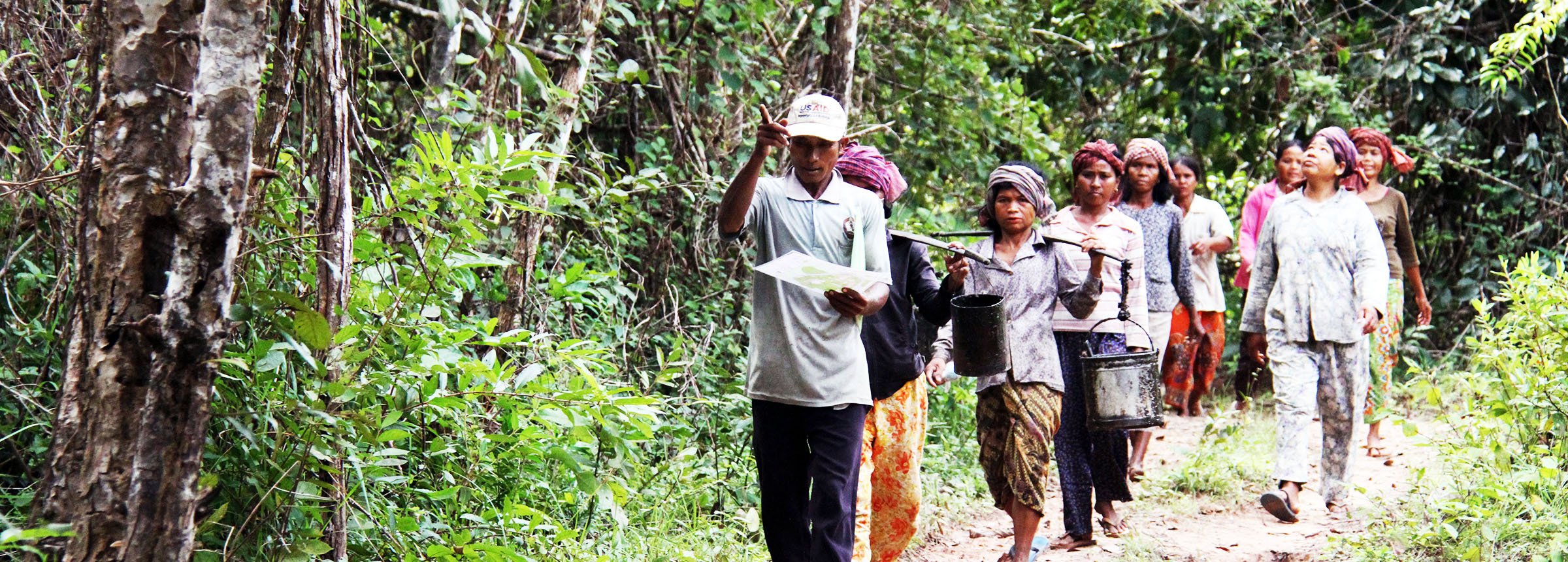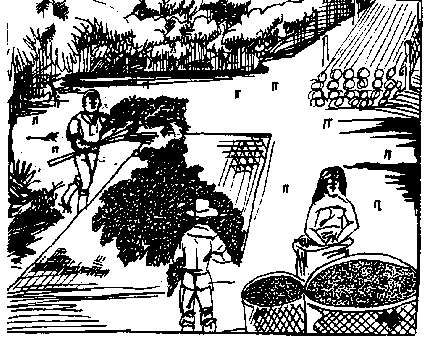
Improving Markets for Farm Forestry Products
FACT 98-02, January 1998
A quick guide to multipurpose trees from around the world
 Traditionally, forestry development programs have focused on improving production and not on the products and their marketing. These programs have successfully raised production levels, but have not been successful in helping farmers meet marketing needs. Producers often lack understanding of basic marketing fundamentals and how best to market their products. To find and penetrate markets effectively, one must have knowledge of critical market information such as supply and demand, and other factors affecting markets for products (Sullivan et al 1991).Many forest farmers are not aware of markets available and the means of getting their products to these markets. The result is that farmers often receive lower prices, are not aware of new or different market opportunities, or have little information to use for planning. Traders visiting local areas are often the only outlets. Producers do not know how to price their products, or determine demand, especially in new or distant markets. This lack of knowledge makes producers ineffective when dealing with middlemen.Increased availability of market information will help producers strengthen their marketing skills and get higher prices, and lead to increased awareness of important marketing practices.
Traditionally, forestry development programs have focused on improving production and not on the products and their marketing. These programs have successfully raised production levels, but have not been successful in helping farmers meet marketing needs. Producers often lack understanding of basic marketing fundamentals and how best to market their products. To find and penetrate markets effectively, one must have knowledge of critical market information such as supply and demand, and other factors affecting markets for products (Sullivan et al 1991).Many forest farmers are not aware of markets available and the means of getting their products to these markets. The result is that farmers often receive lower prices, are not aware of new or different market opportunities, or have little information to use for planning. Traders visiting local areas are often the only outlets. Producers do not know how to price their products, or determine demand, especially in new or distant markets. This lack of knowledge makes producers ineffective when dealing with middlemen.Increased availability of market information will help producers strengthen their marketing skills and get higher prices, and lead to increased awareness of important marketing practices.
The Basics
Marketing involves the many aspects of moving a product from the farm to market (see basic marketing text such as Kotler and Armstrong 1996). Prior to planting the markets for all potential products should be discussed. This may be difficult for products not ready for market until several years in the future, such as timber or fruits.
Producers should understand how to promote their products in the market. They should know how to store products to ensure they do not lose value. Sorting by quality or grade, and packaging products together with similar characteristics will help the product sell quickly and for a higher price. Proper harvest, storage, and transport will help assure that the maximum amount of product reaches market and that the farmer receives the maximum possible return.
Efforts to increase production of agroforestry products should be balanced and should look at all levels of production and handling of products. Producers often suffer from decreased revenues when marketing needs are not addressed.
Increasing markets through improving market information
One key way to improve markets for local producers is to increase access to market information. This can be accomplished by organizing a locally operated market information collection system. The cost of collecting information can be minimal and the importance of marketing reinforced if the producers collect information about the market while on regular marketing or buying trips.
Local farmers need to identify ways to improve marketing of their existing products and plan for future products. A market information checklist included here (see outline in box) is a good place to start. It was developed in the Philippines and tested in several Asian countries (Hammett 1994), and should help producers obtain the information they need to increase returns on current products and help plan for future crops.
First, an assessment of local market information needs, and the identification and evaluation of existing market information sources should be completed. A lack of local marketing expertise and market information for agroforestry products can make this task challenging. Most farmers produce only at the subsistence level; what little they produce in excess of their own needs is sold locally by the roadside or in nearby weekly markets. When surplus production occurs, farmers usually sell to traders or middlemen and do not have the capability to market products in other markets.
Market information should not only provide farmers with support for their marketing efforts, but help them optimize the selection of and mixture of forest and agriculture crops. Increased market information results in increased value for products, more efficient marketing, and improved production levels where further local processing may become feasible.
Guidelines for improved access to market information
The guidelines include steps needed to collect, assemble, and disseminate market information at the local level. The suggested sequence of these steps can be adjusted for other products and sites, and may be adapted to suit evolving farmer needs.
A market information system checklist
- Assess local market information needs
- Identify and organize a group of producers
- Set goals for the group to improve marketing
- Analyze the local situation
- Determine what types of market information are needed
- Select products appropriate for marketing promotion
- Assess available market information (price, quality, volume, seasonal)
- Determine other marketing needs of the group
- Establish market information system
- Develop system by which information is collected and disseminated
- Delegate collection and dissemination duties
- Keep simple records
- Develop framework for sustaining the system
- Determine the support needed to continue the system
- Locate sources of support needed
- Seek support from programs or activities of local organizations
- Keep the program focused on local needs
- Include community input on a continual basis
- Ensure that the system will suit the changing needs of the producers
- Allow for the expansion of the system
It is important to identify existing markets for local products by interviewing key informants in local markets (at farm gate or roadside) within a village or locality where friends or casual acquaintances are sellers and buyers; regional markets (nearby towns or city markets) in which local products are sold; and nearby weekly markets (identify days of these markets). Major traders or large scale industrial buyers in the region can also be key sources of information.
Individual farmers may wish to join a local farmer’s association to collect marketing information. This increases their access to information and helps ensure that collection and dissemination processes are sustained. It is crucial that any existing (formal or informal) market information system be identified and used. Informal sources of market information, such other farmers returning from selling their products, are also valuable. Presence of a central location for information dissemination and close proximity to potential markets are also important.
One should assess the type and frequency of information needed and the timing needed for market information. Longer term production decisions will need historical market data (monthly, and/or yearly), predictive information, and less frequent reporting. For certain perishable products, daily (or hourly) fluctuations may determine the need for more frequent information. One can determine if daily, weekly, or fortnightly price information is necessary.
Appropriate channels of communication for local producers to learn about markets may include relevant producer associations. In Pakistan, a tree farmer association helps individual forest farmers market their products.
It is important to identify a mechanism by which a system can be sustained without outside support. Location of other sources of market information may help save local resources and make the system more sustainable. The potential for involvement and support by participating groups such as farmer associations or cooperatives should also be considered. It is also important to incorporate the needs of local farmers within an existing market information system. Such linkages will save valuable resources and help farmers easily expand the area and products not otherwise included.
Clear, simple records of all market information collected need to be kept. This information will be useful when planning future marketing or production activities. Local users’ ability to comprehend presented information will be an important indicator for determining appropriate dissemination techniques. It is important to select appropriate techniques to transmit information to the target users. This will include determining the appropriate media, such as blackboards posted at major intersections as was used in the Philippines (Hammett 1994). Consideration must also be given to location of dissemination points so that the maximum number of users have access to the information.
It is helpful to determine the effects of any system on producers’ marketing activities. The system should be evaluated in such a manner that increased production and markets can be analyzed and understood by the farmers. Results of such an evaluation would also be useful to extension workers and program planners.
Observations
Developing a locally appropriate system to collect and disseminate market information can be implemented after modest commitment of resources and is suitable for many farm forestry products. Collaboration by farmers as a group and with input from other organizations is important—it saves small producers’ time and valuable resources.
Marketing needs to be flexible enough so that it can be adapted to changing needs of the market place. The testing of farm forestry products before they are produced or marketed is usually not possible. However, through increased knowledge of markets, important indications of product marketability can be gained before valuable resources are committed.
Training in marketing and planning is critical, but often missing from many programs. Exchange of new product ideas and information about markets among farmers will give indications of skills and knowledge needed.
Organizing and implementing a market information system is not complex and is feasible—even for small, local producers. In the Philippines, local farmers now train other farmers how to improve marketing and how to collect and use market information.
An increased focus on marketing will make a difference, especially for small forest farmers needing increased incomes and better planning.
Selected References
Hammett, A. L. 1994. Developing community-based marketing information systems. In: Marketing of Multipurpose Tree Products in Asia. Proceedings of an international workshop held in Baguio City, the Philippines 6-9 December, 1993. Bangkok, Thailand, Winrock International.
pp. 289-300.
Kotler, Philip and George Armstrong. 1996. Marketing: An Introduction. New Jersey, USA. Prentice-Hall. 585 pages.
Sullivan, Gregory M., Susan M. Huke, and Jefferson M. Fox (editors). 1992. Financial and Economic Analyses of Agroforestry Systems. Proceedings of a workshop held in Honolulu, Hawaii, USA, July 1991. Paia, HI: Nitrogen Fixing Tree Association. 312 pages.
A list of related marketing references is available from FACT-Net.
Written by A.L. Hammett, Ph.d,
Center of Forest Products Marketing and Management
210 Cheatham Hall, Virginia Tech
Blacksburg, Virginia 20461-0323 USA
A publication of the Forest, Farm, and Community Tree Network (FACT Net)
